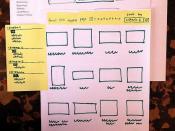Aim:
Do people in all cultures perceive pictures in the same way, and if they do, can we regard pictures as a universal language.
Method:
Review article investigating the differences between cultures in the way they understand pictures.
Sample:
Adults and children from an African country.
Children from a school in Zambia.
Procedure:
African children were shown pictures which contained different depth cues. These included familiar size, overlap and perspective drawings. They were asked 'What do you see? And other questions relevant to the pictures and the study. The questions were asked in the subjects' native language.
Another experiment involved Zambian schoolchildren copying a straightforward trident shape and a trident illusion figure.
Results:
Drawings (elephant man antelope) EXPERIMENT
Correct Incorrect
3D perceivers 2D perceivers
Trident EXPERIMENT
Correct Incorrect
2D perceivers 3D perceivers
Conclusions:
The results quite simply show that those that managed to interpret the drawings correctly, e.g.
managed to distinguish between different depth cues were seen as 3D perceivers.
In the trident experiment those who were able to copy the illusion figure were seen as 2D perceivers as they simply copy what they see as they see the image as being flat, simply a set of lines. On the other hand 3D perceivers could not copy the image correctly as they tried to imagine what the image would actually look like and were therefore confused.
Discussion/Evaluation:
The problem with this study is that there is not enough cross-cultural work involved in the experiment and psychology all together. For too long Psychologists are taking a view that Western principles of human behavior and experience is correct and therefore other actions are always compared to this. This can give a negative view of other cultures and in many cases religions as well.
Strengths and Weaknesses:
The main strength of...



Deregowski.
Not really an essay. You seem to have just written up your notes on the study.
Wouldn't say that the ethical issue you used was really an ethical issue. It's more of an ethnocentricity issue.
0 out of 0 people found this comment useful.